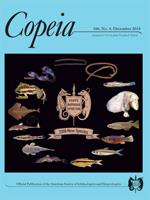The Gulf of Mexico Scientific and Environmental ROV Partnership using Existing iNdustrial Technology (Gulf SERPENT) Project utilizes industrial work-class ROVs based at oceanic oil and gas facilities for scientific research and exploration. During Gulf SERPENT operations, an ROV documented the first in situ observations of Gigantura chuni at a depth of approximately 900 m in the northern Gulf of Mexico. The fish were identified to genus by the length of the caudal fin ventral lobe relative to standard length, reflectance from crystalline guanine, and relative mouth size to the head length. The width-length ratios suggest G. chuni as the species (approximately 1:5 for adult G. chuni vs. 1:10 for adult G. indica). The videos provided the second known in situ observation of giganturids and the first of G. chuni. The first video clearly shows two individuals in close proximity, with both oriented vertically in the water column; a second video clip shows a single individual at a slightly shallower depth, and also oriented vertically in the water column. An odds ratio comparison for collections of G. chuni and G. indica from the DEEPEND program to fitted theoretical distributions was used to preliminarily analyze the probability of encountering various numbers of individuals in a single-sample effort. Groups of two individuals, and in particular even number groupings, were encountered during the DEEPEND program sampling more often than would be expected based on theoretical distributions for both G. chuni and G. indica suggesting pair-bonding may be a likely reproductive strategy complementing synchronous hermaphroditism in giganturids.
BioOne.org will be down briefly for maintenance on 17 December 2024 between 18:00-22:00 Pacific Time US. We apologize for any inconvenience.
How to translate text using browser tools
26 November 2018
The First In Situ Encounter of Gigantura chuni (Giganturidae: Giganturoidei: Aulopiformes: Cyclosquamata: Teleostei), with a Preliminary Investigation of Pair-Bonding
Matthew J. Kupchik,
Mark C. Benfield,
Tracey T. Sutton
ACCESS THE FULL ARTICLE





